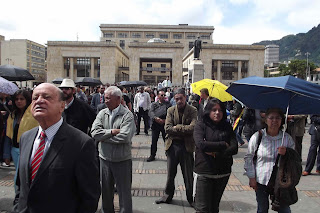 |
| A coca leaf farmer in Bolivia's chapare region about a decade ago. His plot had just been chopped down and burnt by U.S.-backed erradicators. (All photos taken by Mike Ceaser in Bolivia about 12 years ago.) |
If you've ever tried to open a simple Colombian bank account, only to be required to first document your salary, and also bring Chamber of Commerce certificates proving your employer's legitimacy, and God-only-knows what other papers, then you might enjoy this book by two
Los Andes University professors:
Anti-Drug Policies In Colombia: Successes, Failures And Mistakes, by Alejandro Gaviria and Daniel Mejía
.
 |
| Chapare coca leaves, to be made into cocaine. |
According to
this commentary in
The Guardian newspaper, the book argues that rich nations' anti-drug warriors have directed their efforts at the easiest targets: farmers, banks, chemical sellers and others in the producer and transit countries, while the banks and drug retailers in the United States and Europe who earn the great majority of the profits, generally get off easy.
Things are of course much more complex than this, but there's also truth here. After all, the generally impoverished coca leaf or heroin poppy farmer, like the 'boys in the hood' dealing grams on streetcorners in Los Angeles, California, or London are obvious targets without lobbyists in the U.S. Congress. The banking executive, who never actually touches illegal drugs, (except perhaps in his expensive private club) and can argue that he doesn't know the origin of the money he manages, is a difficult target.
 |
A family living in the San Pedro Prison in La Paz, Bolivia.
Most likely, the man was there for a minor
drug-related crime. |
 |
Women examine coca leaves in a legal market in Bolivia.
These leaves are supposed to be used for making tea,
chewing or other traditional uses. |
The Andes University professors' book also points out that only a few percentage points of cocaine's profits actually stay in Colombia (or Peru or Bolivia), while some 97% of the profit is made in the wealthy consuming countries. This is a predictable situation, and not so different in some ways from legal commodities such as cotton and sugar. After all, in those wealthy countries the costs of labor and other services are much higher. With any product, the cost escalates the closer to the final consumer. But with an illegal drug the effect is much more dramatic because the cost of the alkaloid which produces the high is trifling, while the cost of the danger and trouble of transporting the drug halfway across the globe are immense. Just ask Thomas McFadden, the protagonist of the book
Marching Powder, who was locked up in La Paz, Bolivia's hyper-corrupt San Pedro Prison. In San Pedro, McFadden found cheap, plentiful, high quality cocaine. His problem was shipping it to Europe. Standing in the way were transport and bribery costs, the dangers of confistication and arrest and potential violence, all of which raised the final products cost far above what a Colombian campesino could imagine. Of course, the wealthy countries' economies aren't getting rich off of the drug trade, (altho some people and businesses certainly are), since the money also comes from the rich countries' own economies.
 |
| A woman sorts coca leaves in legal market in Bolivia. |
The authors' thesis that producer countries pay a disproportionate cost for the War on Drugs is reasonable, but also debatable. After all, developed nations' prisons are packed with drug criminals - creating huge social and economic costs. But unquestionably it is the producer and transit nations such as Mexico, Guatemala, Honduras, Jamaica and Colombia which have suffered most of the violence and corruption for a failed effort, while seeing only a small slice of the revenue.
Some people would certainly argue that this situation is behind Washington and other power centers' prohibitionist policies in the War on Drugs. I personally doubt it, since this money is simply being recycled thru the rich nations' economies, rather than pumped into them. And, if drugs were legal, then you can be certain that both banks and other big companies (Philip Morris? RJ Reynolds?) would be marketing them. On an
economics forum, Daniel Mejia, one of the new book's authors, offers the hypothesis that wealthy nations back prohibitionism because it transfers the negative impacts from their nations to the producer and transit countries. After all, If drugs were legalized, prices would drop and consumption would rise, along with its associated health problems. Meanwhile, prohibitionism's impacts are mostly in those other, poorer nations.
But legalizing drugs would also reduce crime and prison overcrowding and generate lots of taxes in wealthy nations, giving them a net benefit.
I suspect that the motives behind prohibition are much simpler: The effort against illegal drugs has been labeled a 'war' and no politician likes to lose a war. Meanwhile, the benefits of ending prohibition are longer term and more difficult to see.
If only, 40 years ago, US Pres. Richard Nixon had picked a less simplistic phrase than 'War on Drugs', then it might be easier to make policy shifts today. Nixon left a lot of bad legacies, but this might be one of his worst.
By Mike Ceaser, of
Bogotá Bike Tours
































































